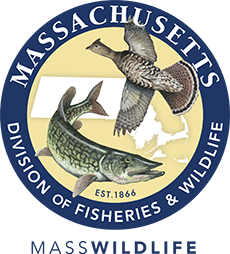- Division of Fisheries and Wildlife
Media Contact
Media Contact, MassWildlife

Land acquisition staff from the Department of Fish and Game (DFG) and MassWildlife collaborated on 26 projects during the last fiscal year (July 1, 2023 – June 30, 2024) protecting nearly 2,500 acres of forests, grasslands, water frontage, and inland water access points. This brings the total amount of land under the care and control of MassWildlife to over 237,000 acres. Land acquisition projects were completed for a total cost of just under $3.5M. Most funding for land acquisition comes from bond capital, with the remaining portion provided by the Wildlands Fund, generated by a $5 fee added to each purchase of a hunting, fishing, or trapping license.
The land acquisition team focuses on properties which provide or improve public access for fishing, hunting, wildlife viewing, and other nature-based recreation. Protecting these lands improves climate resiliency by protecting forests and wetlands that absorb carbon dioxide and floodwaters in extreme weather events. Additionally, connecting large tracts of habitat allows plants and animals to adapt to changing climate conditions. By acquiring land, we conserve the rich biodiversity of Massachusetts by protecting habitats of rare and common species.
MassWildlife often works with conservation partners to help facilitate land protection projects, and this year was no exception. Special thanks go to Essex County Greenbelt Association, Mt. Grace Land Trust, and Franklin Land Trust.
Types of MassWildlife properties:
- Wildlife Management Areas (WMA) are owned by MassWildlife and are open to all for hunting, fishing, trapping, and other outdoor recreation.
- Wildlife Conservation Easements (WCE) are privately owned land where MassWildlife owns the development and recreation rights. These lands are open to all for hunting, fishing, trapping, and other outdoor recreation.
Land acquisition highlights by district
- Northeast District: Over 72 acres along Unkety Brook in Dunstable were protected and will become part of Unkety Brook WMA. The parcel provides important habitat for rare and common wildlife and has beautiful woodland with views of Unkety Brook and surrounding marshes. Much of the property is open to hunting. Eighteen acres in West Newbury were added to Crane Pond WMA, and 21 acres of salt marsh in Salisbury were protected which will simplify and enable marsh restoration activities in the area.
- Southeast District: A 25-acre inholding within Copicut WMA was protected and is now part of the large assemblage of conserved lands known as the Southeastern Massachusetts Bioreserve. The parcel, which is open to hunting, contains mixed upland forest and small grassy fields and provides important forest core habitat for both common and rare wildlife. A 15-acre parcel was protected in Mashpee and will become part of the Santuit Pond Wildlife Conservation Easement.
- Central District: Acreage was added to 5 existing WMAs and 1 new property, Templeton Brook WMA, was formed. The former Templeton Development Center property officially became part of Norcross Hill WMA increasing the size from 500 acres to approximately 2,000 acres.
- Connecticut Valley District: Williamsburg WMA has nearly doubled in size after the addition of 110 acres. The acquisition dramatically improves fishing access to the East Branch of the Mill River and protects sensitive streamside habitats and wildlife travel corridors. The new 14-acre Tekoa Narrows Wildlife Conservation Easement protects sensitive species and provides public access to the Westfield River.
- Western District: One hundred huntable acres were added to Green River WMA including beautiful, forested slopes and 1,000 feet of frontage along the Green River. The 130-acre Edge Hill Wildlife Conservation Easement, an abandoned golf course, was created and brings new opportunities for restoration and recreation.
Land acquisitions by town
| Town(s) | District | Property name | Acres |
|---|---|---|---|
| Douglas | Central | Mine Brook WMA | 20.33 |
| Hardwick | Central | Muddy Brook WMA | 38.31 |
| Lancaster | Central | Bolton Flats WMA | 34.10 |
| Petersham | Central | Popple Camp WMA | 93.00 |
| Templeton | Central | Templeton Brook WMA | 83.03 |
| Templeton,Phillipston,Royalston | Central | Norcross Hill WMA | 1,386.64 |
| Monson | Connecticut Valley | Wales WMA | 27.25 |
| Northfield | Connecticut Valley | Satan's Kingdom WMA | 12.90 |
| Westfield | Connecticut Valley | Tekoa Narrows WCE | 13.99 |
| Whately | Connecticut Valley | Mt. Esther WMA | 12.02 |
| Whately | Connecticut Valley | Great Swamp WMA | 75.00 |
| Williamsburg | Connecticut Valley | Williamsburg WMA | 110.00 |
| Dunstable | Northeast | Unkety Brook WMA | 72.50 |
| Salisbury | Northeast | Salisbury Salt Marsh WMA | 21.00 |
| West Newbury | Northeast | Crane Pond WMA | 18.04 |
| Fall River | Southeast | Copicut WMA | 25.00 |
| Mashpee | Southeast | Santuit Pond WCE | 15.24 |
| Ashfield | Western | Edge Hill WCE | 132.78 |
| Becket | Western | Shales Brook WMA | 73.71 |
| Chester | Western | Hiram H. Fox WMA | 50.00 |
| Egremont | Western | Karner Brook WMA | 17.18 |
| Savoy | Western | Savoy WMA | 4.10 |
| Williamstown | Western | Green River WMA | 100.00 |
| Windsor | Western | Savoy WMA | 41.75 |
| Total | 2477.87 |
